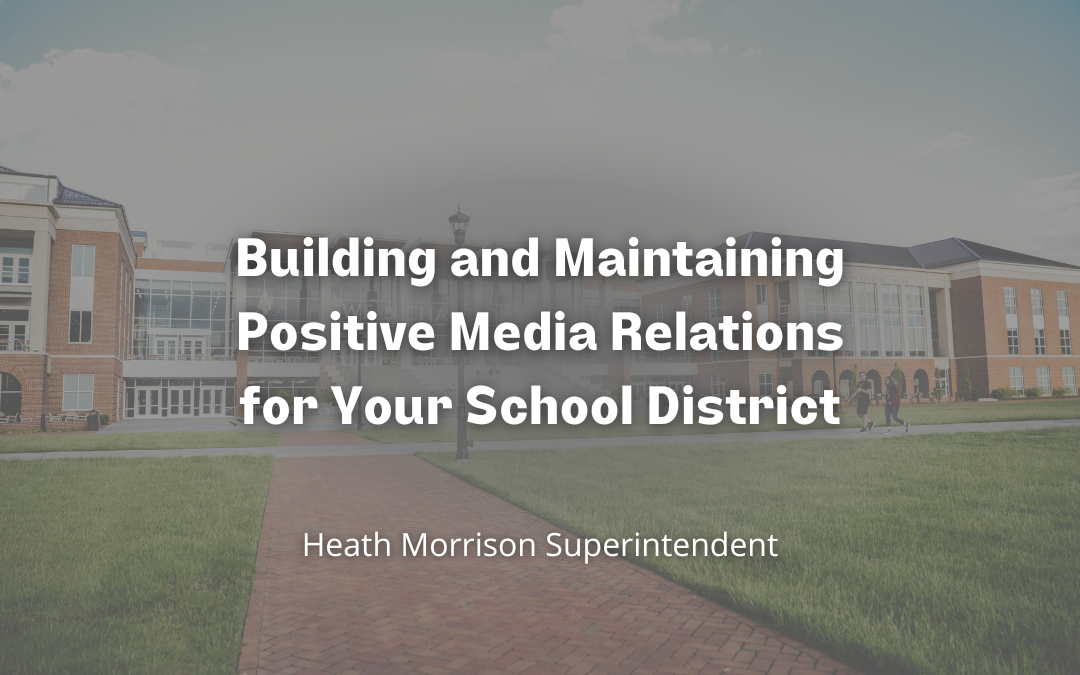A superintendent wears many “hats” in their role as the leader of a school district. From academic instruction, to the operations and finances of the organization, the superintendent must have a broad set of skills and expertise that makes them a successful leader in these areas. One skill that is also critical for a superintendent to master is the ability to build relationships and interact with news media and maintain positive media relations for the district. While most superintendents do have a “Chief Communications Officer” or Director of Communications who advises them on media matters and public relations, the superintendent is the individual ultimately charged by the district’s board of education to be the primary spokesperson for the organization.
Here are some tips for building and maintaining positive media relations for your school district:
- Consider members of the media as your “partners”, not your foes: Oftentimes, leaders of organizations have a tendency to want to avoid the media, fearing negative news coverage. This is not the approach a school district superintendent should take. Media outlets are an important resource for your school district in sharing information and positive stories happening at your schools. It is difficult to maintain a positive public image, or “good PR”, without having positive relationships with members of the media and the outlets in which they work.
- Get to know the news media outlets that cover your district and develop a list: Depending on your region or market, this may vary. It could be that you have only a handful of local news publications that cover your district. These could range from a community-based newspaper to an online-only publication. Or, if you are located in a major media market you may receive news coverage from large scale media outlets, like a state or regional newspaper or ABC, NBA and CBS affiliate. Regardless, you should put in the research and time to get to know the reporters personally. Building personal relationships with reporters and getting to know them by name will improve your ability to maintain effective media relations and generate positive coverage of your school district. Once you have identified the outlets that cover your district, develop a media list for dissemination of important information, like news releases or updates on school closures for weather or other reasons. However, you won’t always use this list when promoting your district to the media, we’ll get to this shortly.
- Understand the audiences of your news organizations: When doing your research on the news media outlets that cover your districts, it is equally important to have a good understanding of their audiences. For example, when pitching a positive story in your district, a news outlet that primarily covers business-related issues may not be interested in a story about the academic accomplishments of your district. They would more likely be interested in an academic function that applies to a particular industry or new construction happening in your district. Additionally, learn the demographics of the media outlet’s audience. Having an understanding of their audience will provide you with some insight on the angle or the direction a reporter may wish to take their coverage on a particular aspect of your district.
- Be respectful of a reporter’s deadline and be transparent: Most of the time, a reporter is operating under a tight deadline. It is important to be respectful of their deadlines when providing them with information or scheduling an interview for a story they are developing. Responding in a timely manner to a reporter’s request will go a long way in developing positive media relations and will earn you the respect of the media outlet. If you need additional time to gather information, be honest about the situation. It is always important to be consistent and remain in communication with a reporter when they are working on a story.
- Be strategic when pitching a positive story: A basic principle of good public relations is being strategic about sharing with the media the positive things happening in your organization. In fact, school districts should include this objective as part of a department or district strategic plan. Pitching stories strategically – over sharing a “pitch” with a mass list of reporters – is equally important in some cases. For example, if you have a story regarding a unique topic (CTE, Bond Campaign, a student achievement, etc.) that you know a particular reporter specializes in or has an interest in, personalize your pitch to them or reach out to offer an exclusive interview. Additionally, if you are planning to make a major announcement about a high-profile retirement or high-profile new hire in your district, offer a reporter who has covered this person or position in the past an exclusive interview with the person. This is another good way to develop positive relationships with reporters while generating positive coverage of your district.
Maintaining positive media relations with your local news reporters is important as you work to develop positive public relations with your community. Don’t confuse media relations with public relations. Media relations is, in essence, how you are received or connected with the news outlets that cover your organization, while public relations is how you are perceived by your community. The media is an important partner for you in conveying the positive stories in your district to the public. That is why building and maintaining positive media relations is critical for a superintendent.

